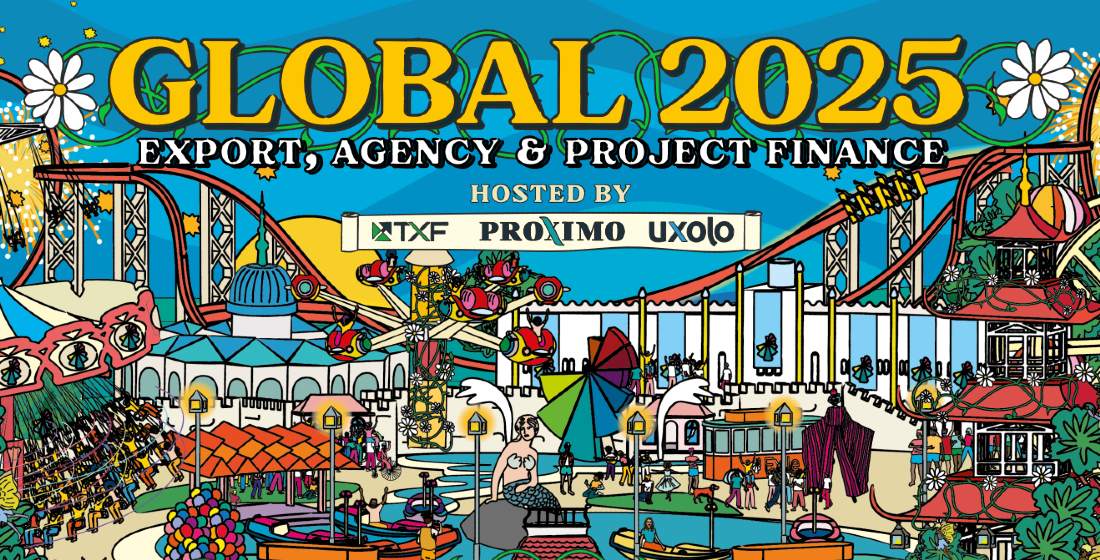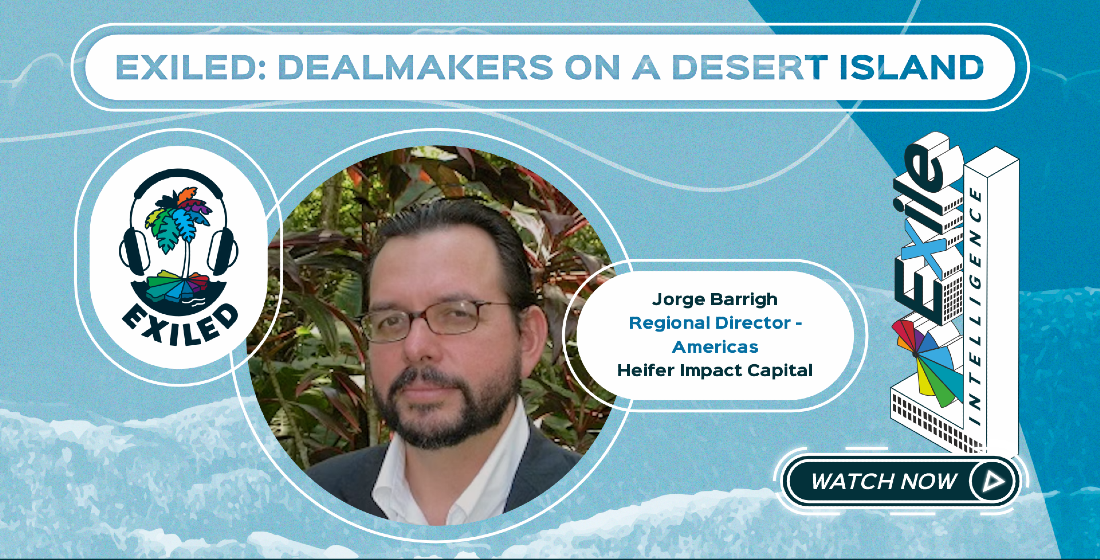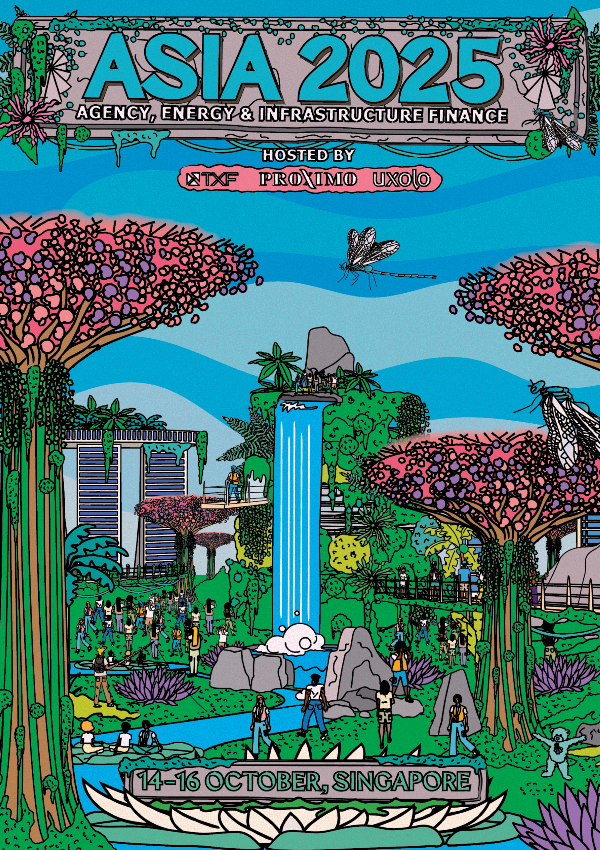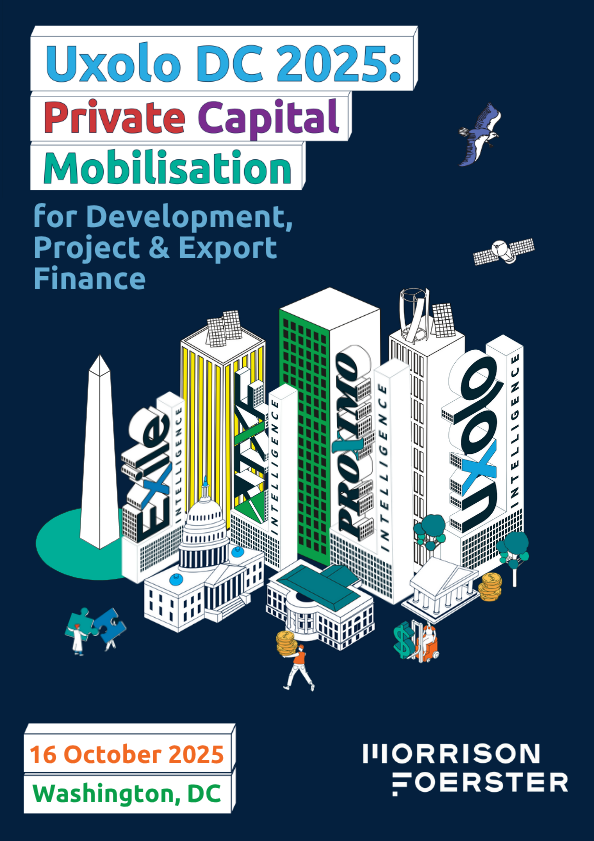Uxolo Development Finance Awards 2021: Pathfinders through the pandemic
In the first part of the inaugural Uxolo Awards we look at the best providers and financial engineering innovations in development finance in 2021.

There have been few years when development finance institutions have been tasked with more, although 2022-2023 will likely see an even greater uptick on the demand for DFI/MDB backing. Despite the enormity of fallout from the Covid-19 pandemic, innovation was rife in 2021, not only in pandemic-related funding but on all the SDGs. Uxolo is recognising those achievements with the launch of its annual awards, an independent and editorially-driven take on the best of development finance in 2021. This week we look at the best in development policy funding and innovative financial engineering.
Uxolo will be presenting the awards at the Uxolo Global 2022: Development & Impact Finance hybrid event in the Hague on 11 October 2022. Winners will be contacted, but if you would like to attend on behalf of your agency to receive the award please contact sam.mcmanus@uxolo.com
Multilateral of the Year 2021
African Development Bank
In its effort to support Africa through the COVID-19 pandemic in 2021, the African Development Bank increased its overall funding activities from $5.84 billion approved in 2020 to $6.31 billion in 2021. It was a remarkable year of innovation for the multilateral development bank (MDB) – compared to its more heavily funded peers – critically funding vaccine supply and reviving economic activity.
Despite the pandemic-related challenges, the AfDB maintained its Triple-A rating with a stable outlook by the four major global credit rating agencies – Standard & Poor’s, Fitch, Moody’s, and Japan Credit Rating Agency – for the sixth year in a row.
In 2021, AfDB recognised that a holistic recovery from the pandemic would involve building resilience in economic and health sectors across the continent. The multilateral reprioritised its lending program from an emphasis on program-based operations in 2020 to investment projects in 2021. AfDB approved its Debt Action Plan to help address fiscal and debt stress in its regional member countries and make debt work better for the continent. And in February last year, the bank’s Strategy for Economic Governance in Africa (SEGA) was approved to address the rising public debt burdens in African countries, reduce leakages for a more effective public sector, and foster an ecosystem that drives investment and private sector growth in the continent.
A notable challenge in 2021 was the inequitable distribution of vaccines in Africa as compared to the Global North. Recognising the fundamental need for vaccination in post-COVID recovery, the AfDB called for global vaccine justice, efficient delivery, and solidarity. Recovery from the pandemic has been especially challenging, considering the high public debt in many African countries, which has limited their ability to increase spending and finance to bounce back.
Despite the pandemic placing a massive strain on the lending capacity of MDBs around the world, AfDB did not take its eyes off the climate change targets. The MDB increased its climate finance to 41 percent of its total approvals for 2021, amounting to $2.6 billion, a 7% increase compared to 2020. Within its climate finance umbrella, 67% was committed to adaptation ($ 1.7 billion) and 33% to mitigation ($853.3 million). Among the significant achievements have been the installation of 285MW of new energy capacity to light up and power Africa, including 72MW of renewable energy.
Even though the continent contributes comparatively little to carbon emissions as compared to the developed countries, the impact of climate change will be disproportionately felt among its vulnerable populations. ‘Just transition’, therefore, has been incorporated into the climate finance agenda of the AfDB. In 2021, 92% of all approved projects, country strategies, and policy documents kept in mind climate change and green growth considerations.
The top goals of the multilateral bank have been addressing poverty and hunger (SDG 1 and 2) in the continent. In 2021, AfDB financed the building and rehabilitation of 1,386 kilometres of roads and provided 9,500 hectares of land with improved water management. The benefit of these improvements in agricultural infrastructure is expected to benefit 3.7 million. To industrialise Africa, AfDB provided 133,600 small, and medium-sized enterprises access to financial services, while 3.4 million people benefited from investee projects. To integrate Africa, the MDB secured access to better transport services for 6.6 million people and constructed or rehabilitated 262 kilometres of cross-border roads. To improve the quality of life for the people of Africa, AfDB provided 12.2 million people with new or improved access to water and sanitation and 130,000 people with better access to education.
Meeting all its goals in any year would be an achievement given AfDB sets its bar high. Meeting all its goals in a pandemic year speaks for itself.
Impact Fund of the Year 2021
Climate Investor 2
Climate Investor 2 (CI2) has been a pioneering blended finance facility focusing on water and ocean conservation. Successfully following its renewable energy sibling – Climate Investor One – reached a $675 million first close in 2021.
With a $1 billion target fund size, CI2 aims to provide expertise, technology, and financing to climate-related infrastructure projects in emerging markets by mobilising private sector financing at scale, supported by catalytic public sector donor funding. Building on CI1s’s focus on renewable energy, Climate Fund Manager has added water, sanitation, and ocean infrastructure to CI2’s investment mandate.
Water, sanitation, and ocean are Sustainable Development Goals that are not only much more challenging to fund than renewable energy, but are also often perceived to yield high risk and low returns. CI2 took this challenge head-on. Bolstered by strong support from the government of the Netherlands, CI2 uses the same blended finance structure as CI1, which aims to simplify and expedite the manner in which capital is deployed by providing a single financing source for each of the respective development, construction, and operational phases of a project’s lifecycle.
Through its CI2 Development Fund, CI2 will provide early-stage project development services and financing; and through its CI2 Construction Equity Fund, CI2 will offer equity finance that accelerates project construction. “The two main ambitions that we had were to, firstly, contribute to the fight against climate change, and to do it quickly and at scale because we only have eight years left to lock in 1.5 degrees,” says Climate Fund Managers’ George Beukering, in an interview with Uxolo. “And secondly, we wanted to attract the private sector, because that’s where the real budgets are – we need trillions of dollars to keep within a 1.5 degrees increase and we only have $150 billion annually of official development aid, and that’s why we’re using blended finance.”
CI2 is made up of two funds. The Development Fund is used to prepare projects during the development stage. The development stage has higher perceived risk and low capital-intensity. “There’s all kinds of ideas and nice locations but many projects never reach the finish line. The process often takes years and there are very few parties out there willing to finance it, and we’re one of them,” says Beukering.
Then there’s the Construction Equity Fund, which provides follow-on financing once a project has been successfully made ‘bankable’. “We provide construction finance to take the project through the construction phase – usually with equity only because we found that project finance, while a proven methodology to finance projects, is very cumbersome and takes a lot of time, so we decided to only bring in the banks in the third and final stage, the operational phase. So we tend to equity finance our construction with shareholder funding only, and then bring in the needed leverage in the operational stage. This fund also comprises three tranches – called Tier 1, Tier 2 and Tier 3 – and each of those four investor groups are invested in one of them. The Tier 1 is for the donors, who also invest in the Development Fund,” says Beukering.
CFM does not plan to buy old investments, and is keen on developing rather than refinancing. “And refinancing refers to the debt financing that we’ll then provide to our project companies during the operational stage. And then the fourth milestone is the exit. And all of that, we’re looking to do within six to eight years,” says Beukering.
The model is ambitious, achievable, and highly replicable, making it a deserving winner of Uxolo’s Impact Fund of the Year award.
Consultancy of the Year 2021
Social Finance
Founded in 2007, Social Finance – a not-for-profit consultancy that partners with governments, service providers, the voluntary sector, and the financial community to find better ways of tackling social problems in the UK and globally – has best been known for its pioneering Social Impact Bond (SIB). The SIB model has created unique public-private partnerships that fund effective social services through performance-based contracts. Since SIB was established in 2010, it has mobilised more than £500 million globally While impact investors provide the capital to scale the work of high-quality service providers, the government repays those investors if and when the project achieves outcomes that generate public value.
This model – which was first launched to reduce reoffending in Peterborough, UK – has been used innovatively to address a host of social problems like pregnant people who are experiencing poverty to achieve healthy births and training immigrants and refugees to find employment. Social impact bonds transfer risk from the public to the private sector and align project partners on the achievement of meaningful impact.
2021 was a year Social Finance’s unique model was most tested. The COVID-19 pandemic demanded that the projects funded through Social Impact Bonds had to be flexible enough to cope with change, but still deliver the transfer of financial risk from the public to private sectors that they are designed to achieve. The not-for-profit consultancy successfully ensured that the challenges were adequately met by collaborating with partners across sectors and countries to help them reshape future services in a range of issues including children’s services, health, and community care, skills and employment, domestic abuse, and housing.
The success of SIB meant that the template was highly replicable. Development Impact Bond (DIB) has been a successor of SIB, following the same funding model. The DIB model found much success in 2021 – almost a decade since it was launched – particularly in the lower and middle-income countries in the field of healthcare and education. Notably, in December 2018, the Cameroon Ministry of Public Health, Global Financing Facility for Women, Children and Adolescents (GFF) and World Bank, Grand Challenges Canada, Nutrition International and the Foundation Kangourou Cameroun, with the support of the Fundación Canguro Colombia, launched the Cameroon Kangaroo Mother Care (KMC) Development Impact Bond (DIB).
The DIB successfully equipped 10 hospitals to deliver quality KMC, trained 47 neonatal clinicians and 121 community health workers to support mothers in delivery of KMC to low-birth-weight babies. As a result, 1221 babies received quality KMC, 28% percent above the DIB target of 951 babies. 80% babies were exclusively breastfed at point of discharge from hospital and 80% percent of babies had appropriate weight gain at 40 weeks gestational age.
Through its reports series ‘Changing Lives, Changing Systems’, Social Finance shared learning from practical experience of impact at scale. It focused on Reconnections, a service that aims to address loneliness and social isolation among older people. Reconnections was transferred to Independent Age – a leading UK wide charity that supports older people and has the specialist skills and resources to replicate it.
Social Finance has superseded its impact mandates, making it a deserving winner of our Consultancy of the Year 2021 award.
DFI of the Year 2021
FMO
Most consistently investing its money exactly where its mandate is, FMO stood out among all DFIs in 2021 for making ambitious and diverse financing that directly addresses the 17 Sustainable Development Goals.
Even though the Dutch development bank works across all SDGs, it has a particular focus on three: decent work and economic growth (SDG8), reduced inequalities (SDG10) and climate action (SDG13). In 2021, the DFI exceeded its target for new investments in reducing inequalities amounting to €714 million (target was €596), but did not reach its target for new investments in green projects (€544 million in 2021, target was €592), while their outstanding portfolio supported an estimated 644,119 direct and indirect jobs (2020 figures were 672,492).
FMO’s mandate for reducing inequality is aimed to create greater social and economic inclusion and create opportunities for small businesses, smallholder farmers, youth, women, rural populations, migrants, and refugees through financial inclusion, women's economic empowerment, and access to energy. For instance, in 2021, FMO and Rabobank agreed to invest €10 million each in the IDH Farmfit Fund. The €100 million IDH Farmfit Fund makes investments in smallholder farmers affordable by lowering risks and costs for both farmers and investors. The credits allow farmers to invest in their farm, increase productivity and exit the cycle of poverty.
Keeping the human impact of energy transition in the centre – or better known as ‘just transition’ – FMO’s financing strategy has incorporated inequalities in renewables projects. Notably last year, FMO announced the financing for the construction and operation of four solar plants in Burkina Faso. Burkina Faso is one of the poorest countries in the world, where only 1 in 5 people have access to electricity. Currently, 85 percent of the country’s grid is powered by diesel generators, with the fuel imported by road or through electricity imports from neighbouring countries.
Broken supply chains, increased costs of solar components, and continued COVID lockdowns have crippled the energy access industry. In 2021, through the Access to Energy Fund, FMO invested in the Energy Access Relief Fund (EARF) – a partnership between 16 governments, foundations, and investors. The EARF, managed by Social Investment Managers and Advisors (SIMA), will provide relief capital in the form of short-term loans to an estimated 90 energy access companies in sub-Saharan Africa and Asia still struggling with disruptions wrought by COVID-19.
FMO’s impact and development financing has not been without substantial profits. The DFI made a profit in 2021 of €491 million – a significant improvement compared to the end of 2020 when they reported a loss of €205 million. The DFI believes that there are three main drivers that explain this development. First, economies have largely recovered after the initial COVID-19 shock, which has led to a significant upward revaluation of FMO’s Private Equity portfolio. Second, the appreciation of the US dollar has had a positive effect on the value of its assets. Third, despite the initial negative outlook, most of FMO's customers were able to meet their financial obligations, which has led to a net release in impairment levels.
National Development Bank of the Year 2021
BNDES
Radically changing its approach towards ESG financing, delivering on impact promises, and yielding unprecedented profits have been the defining achievements of BNDES in 2021. Going bullish on ESG projects by changing its lending policy, BNDES made profits of BRL34.1 billion in 2021 – a record in its history and 65% above 2020.
At the end of 2021, 53.5% of BNDES credit operations (considering direct and indirect non-automatic operations) were linked to projects that supported the green economy and social development. In the year, disbursements for initiatives of this nature totalled BRL7.8 billion and BRL10.0 billion.
About 83% of disbursements (BRL53.5 billion) in the year contributed to the Sustainable Development Goals, totalling almost 180 thousand operations. In all, the Brazilian development bank financed the generation of 1,730MW of wind energy – enough to supply 3.3 million homes – 3,197 km of natural gas distribution network were implemented and 2,142 cisterns were built in rural public schools, among other. The main example of success in SDG financing in 2021 was the concession auctions for the four sanitation blocks in Rio de Janeiro, which raised BRL24.8 billion and are expected to generate BRL32 billion in investments.
The Brazilian development bank’s new strategy of leveraging its role to bring in private sector capacity went beyond financial gains to incorporate diverse industry expertise. BNDES has a staff of 2,500, and more than 1,000 of those employees have master’s degrees or PhDs. The bank is now focusing this expertise and experience to structure concessions, auctions, and projects that will meet technical, and environmental standards – as well as financial targets – that can then be passed over to the private sector. The bank has also pushed for changes to the country’s legal and regulatory environment – such as bringing non-recourse financing to Brazil. The early results have been a renewed level of interest in – and competitiveness of – tenders for public assets.
In 2021, the development bank made a bold shift away from subsidising Brazil’s largest corporations – a policy from previous administrations that subsidised very large Brazilian companies with the objective of making them global players – no matter that the beneficiaries were a small number of already-rich private sector owners.
The policy shift found sovereign support. The Brazilian government extended BNDES’ emergency credit lines that it deployed during the pandemic to help SMEs. These will now become permanent credit lines to help grow an underdeveloped commercial segment in Brazil given the country’s historically high-interest rates and risk-averse banking sector. “It creates a new market – the SME market in Brazil grew 50% in the last two years, from $520 billion to $830 billion – and that was during a pandemic!,” said Gustavo Montezano, president of BNDES, in an interview with Uxolo. “And the reason for that is [state] credit issuance to the sector – it’s an old-fashioned concept elsewhere in the world but in Brazil it’s a huge innovation. And once we opened this agenda to the political class in Brazil they realised that it makes no sense to give subsidies to large companies.”
BNDES ended 2021 with 167 projects in its portfolio, of which 19 have already been auctioned, totalling planned investments of around BRL383 billion – BRL109 billion referring to projects already auctioned. The development bank has taken on policy risks and has prioritised social and environmental impact alongside financial gains, setting a blueprint for other national development banks around the world to follow in 2022.
Green Bond of the Year 2021
KfW
KfW broke several records with its green bonds in 2021. Known for going bullish on green financing, Germany's development bank KfW broke its previous records in 2021 and issued a five-year $3 billion US dollar-denominated green bond – the largest dollar-dominated green bond across all sectors in 2021.
This $3 billion green bond takes KfW’s total green funding volume to €15 billion – a new milestone for KfW’s green financing. The green bond not only set a record in terms of its volume but was also a big hit with investors. The $3 billion US dollar-dominated green bond was nearly four times oversubscribed, demonstrating its success in the bond market.
This was the first KfW US dollar fixed rate benchmark to be marketed and priced vs SOFR mid-swaps. Final orders reached more than $11 billion (excluding JLM interest), which represents the largest ever order book for a SSA US dollar Green bond.
In 2021, KfW proliferated into various currencies. The German development bank issued 37 “Green Bonds – Made by KfW” in 13 currencies. The issuances comprise 22 new lines as well as ten re-openings of three 2019 green bonds (GBP, NOK and AUD) and five re-openings of 2021 green bonds (EUR, CNY and ZAR).
Strong high-quality and price-insensitive demand allowed the issuer to tighten pricing by 2bps from IPTs. Landing at SOFR MS+19bps, this deal priced flat to fair value, whilst a conventional KfW US dollar 5-year bond would have typically required a ~2bp new issue concession.
An amount equal to the total net proceeds of KfW’s Green Bonds issued in 2021 were fully allocated to disbursements in projects mitigating climate change in the categories of renewable energies (KfW loan programme “Renewable Energies - Standard”) and energy efficiency (KfW loan programme “Energy-efficient Construction”).
KfW’s $3 billion green bond has proven to be a highly and successful replicable green financing vehicle, making it a worthy winner of the Green Bond of the Year award.
- Amount: $3 billion
- Issuer: KfW
- Guarantor: Federal Republic of Germany
- Rating: Triple-A
- Pricing Date: 13 October 2021
- Maturity Date: 01 October 2026
- Coupon: 1%
- Reoffer Price / Yield: 99.458% / 1.113% s.a.
- Swap Spread: SOFR mid-swaps + 19bps
- Benchmark Spread: UST 0.875% 09/2026 + 5.25bps
- Joint Lead Managers: BofA Securities, HSBC Continental Europe and TD Securities
Gender Equality Development Deal of the Year
JICA
In 2021, the Japan International Cooperation Agency (JICA) issued a first-of-its-kind gender bond in Japan to boost the employment and education of women and promote gender equality in developing countries. The government-backed aid agency raised a combined JPY20 billion in bonds ($181 million) – JPY10 billion with a 10-year maturity and JPY10 billion with a 20-year maturity – to fund projects in places where women do not have the same opportunities as men to receive education, work, and participate in political activities.
In a year that witnessed a spike in domestic violence against women owing to the COVID-19 pandemic-related lockdowns, a gender bond of this scale ensures that women are financially independent and empowered. Financial independence is among the many significant ways to escape abuse. JICA’s gender bond aims to foster financial independence among women in its post-COVID recovery strategy.
The $181 million gender bond addresses SDG 5 (gender equality), ensuring women’s participation is critical in post-COVID recovery. Financial empowerment among is more important now, than ever before. Ten million additional child marriages may occur before the end of the decade, threatening years of progress in reducing the practice, according to a new analysis released by UNICEF in 2021. School closures, economic stress, service disruptions, pregnancy, and parental deaths due to the pandemic are putting the most vulnerable girls at increased risk of child marriage.
JICA works for ‘Gender Equality and Women’s empowerment’ as a key development agenda cutting across all thematic areas in developing countries. COVID-19 pandemic has compounded existing gender inequalities. By launching gender bonds, JICA aims to strengthen its efforts for addressing gender inequality amid the crisis and toward post-pandemic future.
JICA's gender bonds are part of social bonds that are used to address various challenges. The bonds have the features of “Social Bonds” defined by the International Capital Market Association (ICMA) and are qualified by a second party opinion from an independent third party (Japan Research Institute). The bond proceeds will be allocated to JICA’s Finance and Investment work for projects which meet gender equality project criteria as defined by the OECD-DAC. This includes projects where the main objective is gender equality, and also where gender equality is an important and deliberate objective but is not the principal reason for the project.
- Issue amount: JPY10 billion
- Issuer: JICA
- Maturity period: 10 years
- Launch date: September 16, 2021
- Issue date: September 27, 2021
- Maturity date: September 27, 2031
- Coupon: 0.110%
- Rating: A+ (S&P), AA+ (R&I)
- Lead manager: Mitsubishi UFJ Morgan Stanley Securities Co, Barclays Securities Japan, Mizuho Securities and Tokai Tokyo Securities
- Issue amount: JPY10 billion
- Maturity period: 20 years
- Launch date: September 16, 2021
- Issue date: September 27, 2021
- Maturity date: September 27, 2041
- Coupon: 0.439%
- Rating: A+ (S&P), AA+ (R&I)
- Lead manager: Mitsubishi UFJ Morgan Stanley Securities Co, Mizuho Securities and SMBC Nikko Securities
Environmental Financing of the Year and Overall Deal of the Year 2021
Belize Blue Bond
Representing the world’s largest debt restructuring for marine conservation, The Nature Conservancy’s (TNC) innovative $364 million financial transaction with the Government of Belize will enable the country to reduce its debt burden and generate an estimated $180 million for marine conservation. This is in support of Belize’s commitment to protect 30% of its ocean, strengthen governance frameworks for domestic and high sea fisheries, and establish a regulatory framework for coastal blue carbon projects. The Belize Blue Bond is especially meaningful to the people of Belize as the country’s tourist-based economy continues to suffer from the impacts of COVID-19.
The $364 million financing is part of TNC’s Blue Bonds for Ocean Conservation program – an ambitious plan to drastically scale-up durable ocean conservation around the world. This conservation model is an innovative strategy to work with governments to restructure a portion of their sovereign debt, securing long-term sustainable financing for the management of valuable natural resources. This approach helps governments unlock funds at scale to deliver on their conservation goals and support the well-being of their communities and economies.
In Belize, this project will provide crucial support for the country and its people by restructuring $553 million of the country’s debt, generating approximately $4 million per year in support of marine protection and tripling Belize’s budget for ocean conservation programs over the next two decades.
Despite the ocean contributing an estimated $3 trillion per year to the global GDP, marine conservation is continually one of the most often overlooked and underfunded of the Sustainable Development Goals, posing both a serious economic risk and a missed economic opportunity. With a plan to work with countries across the Caribbean, Africa, Latin America and Asia-Pacific regions in the coming years, TNC aims to use these debt transactions to help ensure the new protection of up to 1.5 million square miles (4 million km2) of the world’s most biodiversity-critical ocean habitats – a 15% increase in the amount of protected ocean than currently exists.
Proceeds of the Blue Bonds are being used by Belize to repurchase a portion of its US dollar bonds due 2034, reducing debt service costs and improving long-term debt sustainability. A portion of the financing, $23.5 million, will also be placed into an endowment that will set aside funding for marine conservation accessible from 2041, ultimately aiding in the long-term planning and protection of Belize’s marine ecosystems. As part of the terms of this transaction, approximately $4 million annually, paid in Belize dollars, over the next 20 years will flow to a new, independent conservation fund for Belize, which will disburse funds to marine and coastal conservation projects. In addition, TNC and Belize agreed to numerous conservation commitments and milestones that will help achieve Belize’s conservation goals to the benefit of nature, the Belizean people and the country’s economy.
TNC’s previous experience has proved that these debt conversions work and is a highly replicable model in the emerging markets: TNC’s 2016 transaction with the Republic of Seychelles allowed the country to generate up to $430,000 per year to marine conservation and protect 410,000 square kms of ocean – an area twice the size of the UK.
This debt conversion approach can be especially buoying to countries whose economies rely heavily on fishing and tourism. In Belize, tourism contributes 41% to the national GDP and employs 13% of the workforce. Tourism, especially nature-based tourism, is one of the largest sectors of the Belizean economy; coral reefs alone generate some $81 million in annual tourism expenditures. The sector was heavily impacted by COVID-19: The country experienced an 85.5% decrease in overnight visitors in January 2021 as compared to January 2020.
Adopting the Blue Bonds for Conservation model in Belize to unlock sustainable funding for marine conservation supports the blue economy, and protects and improves management of the ocean and coasts – benefiting both people and the planet – making it a deserving winner of Environmental Financing of the Year and Overall Deal of the Year.
- Closed: November 2021
- Borrower: The Nature Conservancy
- Debt: $364 million
- Arranger: Credit Suisse
- Insurer: US Development Finance Corporation
Blended Finance Deal of the Year 2021
Canal Sugar
2021 ended with a major multi-sourced deal in Egypt: the $750 million long term syndicated facility backing the Canal Sugar Project. The deal bodes well for sustainable financing in Africa and adds additional substance to the argument that blended and multi-sourced financing could yet play a bigger role in big-ticket projects in developing markets.
Canal Sugar Company – a joint venture between Jamal Al Ghurair Group, Al Ahly Capital Holding (the private equity arm of the National Bank of Egypt) and Murban Energy (a UAE-based investment fund) – is developing a greenfield agro-processing project comprising a 181,000 feddans (186,000 acres) farm, of which 122,000 feddans will be reclaimed land, and a 937,000 tons/year sugar processing factory in Al Minya Governorate in Egypt.
The EGP17 billion ($1.08 billion) scheme is amongst the largest private agricultural projects in Egypt in decades and capitalises on automation, mechanisation and precision farming. The project has significant benefit for Egyptian food security, increasing the country’s agricultural plot as well as agri-food facilities. More than 1.3 million tons of sugar beet per year will be produced on the farm, in addition to 250,000 tons of other crops such as wheat, maize and chickpeas. Via modern farming techniques the farm is expected to reach a high beet yield of 35 tons/feddan which will meet around a third of the sugar factory's required inputs, the remainder to come from beet sourced from local farmers.
The project was initiated with a $169 million bridge financing from National Bank of Egypt, QNB Alahli, Bank of Alexandria, Industrial Development Bank of Egypt, Suez Canal Bank and The United Bank in 2019. The long-term debt finally signed on 13 December 2021, a measure of the complex balancing act involved in blending the different lenders but also the need to provide a solution in multiple denominations because of the large and diversified supplier and contractor base for the project and ultimately its mixed denomination income stream from domestic sales and exports.
The final deal financed on a 69/31 debt-to-equity ratio. The multi-currency facility comprises a EGP7457 billion 12-year tranche provided by National Bank of Egypt, QNB Alahli, Banque du Caire, Suez Canal Bank, The United Bank, Arab Investment Bank, Agricultural Bank of Egypt, Housing & Development Bank and Industrial Development Bank; a $67 million 10-year tranche also provided by National Bank of Egypt, QNB Alahli, Suez Canal Bank and The United Bank; a $56 million 10-year piece solely provided by National Bank of Egypt; and a €135 million 11.5-year tranche provided by National Bank of Egypt and Afreximbank. Baker & McKenzie provided lender counsel, while Norton Rose Fulbright and Zulficar & Partners acted for the borrower. Legal counsel on the ECA facility were Latham & Watkins and Matouk Bassiouny & Hennawy.
The euro denominated tranche and the $56 million tranche are actually on-lending facilities provided to the lenders of record, structurally a first for the Egyptian project market. HSBC arranged the euro tranche, which is Hermes-covered and provided by two German lenders to National Bank of Egypt (€35 million) and Afreximbank (€100 million) for on-lending to finance procurement of equipment for the sugar beet factory. The dollar on-lending facility is a murabaha provided by state-owned Saudi Fund for Development to National Bank of Egypt to finance equipment imported from Saudi for the farm. The remainder of the debt, provided by Egyptian banks, finances foreign and domestic capex.
Saudi conglomerate Al Khoyaref Group is provider of 1000 fully automated centre pivot irrigation systems for the farm, along with a maintenance agreement and precision land farming operations agreement. China-based Sinoma CDI is EPC for the beet plant. And El Sewedy Electric is installing ultra-high voltage overhead transmission lines from the main substation in West Mallawi to the project site and building substations to feed the beet plant and farm.
- Signed: December 2021
- Debt: $750 million
- Lenders: National Bank of Egypt, QNB Alahli, Banque Du Caire, Suez Canal Bank, The United Bank, Arab Investment Bank, Agricultural Bank of Egypt, Housing & Development Bank, Industrial Development Bank
- Risk cover: Hermes
- ECA Arranger: HSBC
- ECA legal counsel: Latham & Watkins; Matouk Bassiouny & Hennawy.
- Islamic lender: Saudi Fund for Development
- Lender counsel: Baker & McKenzie
- Borrower counsel: Norton Rose Fullbright, Zufilcar & Partners





